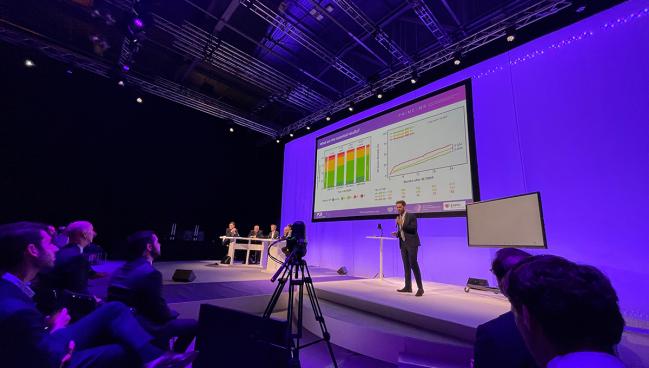Real-World TEER Outcomes in Primary MR Make Gains, but Questions Remain
The registry results represent some of the largest, real-world insights into how TEER is panning out in primary MR.

LONDON, England—Complication rates among patients with primary mitral regurgitation (MR) undergoing transcatheter edge-to-edge repair (TEER) have been steadily declining, as have rates of residual MR, according to the largest dedicated registry of such patients getting a clip device.
But as Benedikt Koell, MD (University Heart Center Hamburg, Germany), showed here at PCR London Valves earlier this week, the patient mix undergoing the procedure is also less complex today than it was back when the registry launched in 2008.
The EVEREST II trial enrolled both primary and functional MR patients, paving the way for the MitraClip’s (Abbott) approval in patients with primary MR who were not good candidates for surgery. The CLASP IID and CLASP IIF trials, meanwhile, are studying the Pascal device (Edwards Lifesciences) in the primary and secondary populations. On the whole, it’s the functional MR population that has seen the most in the way of randomized trials (such as COAPT and MITRA-FR), while most registries have tended to track both patient groups, Koell noted.
As such, PRIME-MR, an international, investigator-initiated registry focused exclusively on primary MR patients turned down for surgery from 24 international high-volume TEER centers, can provide some of the best real-world data as to how clip repair is panning out for this group, Koell said.
Real-World Usage
This snapshot from PRIME-MR includes 2,363 primary MR patients treated with TEER between 2008 and 2022. Age and comorbidities were the main reasons for surgical denial. Nearly 84% had isolated primary MR. The remainder had mixed MR, but with primary as the leading cause. In nearly half of patients, flail leaflet was the main cause of their MR, followed by prolapse in 44%. Roughly 38% of patients received the first-generation MitraClip, 36% got the second-generation device, 20% had third- or fourth-generation MitraClip devices, and 6% received an Edwards Pascal device.
Looking at trends since 2008, Koell noted that the proportion of patients with NYHA class III/IV heart failure has been dropping over the last 14 years, from 86.2% in 2008-2013 to 67% in 2020-2022. STS score, too, has declined over the same period: from 5.7 to 4.8.
Safety has also been steadily improving, with the proportion of patients experiencing no MVARC complications rising from 45.8% to 54.7% between 2008 and 2022, while the need for reintervention, by contrast, has fallen from 4.8% to 2.3%, both statistically significant differences. Bleeding rates, both major and minor, have also ticked downwards.
Residual MR Remains Key
The findings that generated the most discussion at PCR London Valves, however, were the rates of residual MR.
The proportion of patients with grade 1+ or less has steadily increased over the years while those with 4+ has declined, but as Martin Leon, MD (NewYork-Presbyterian/Columbia University Irving Medical Center, New York, NY), pointed out in discussion following Koell’s presentation, other registries have shown even better rates of none or trace MR. The Abbott-sponsored MitraClip EXPAND G4 registry—results for which were shown in the same session, and at the earlier TCT 2022 meeting—included a mixed primary/secondary MR cohort and showed rates of 1+ MR or less as high as 90%, depending on the type of clips used.
That may reflect the difference between a “real-world” registry including experienced operators familiar with earlier iterations of the device and an “open registry,” said Leon, “with variations in experience level, maybe more-complex anatomy as opposed to a prospective registry with more-experienced sites and with a little more control, perhaps, over the entry criteria, from the standpoint of anatomy.”
Koell, in response, said it’s difficult to explain, but might relate in part to the high proportion of patients with flail leaflet as their underlying cause, which can make for a trickier clip procedure, particularly with the earlier repair devices. Whether newer iterations help to improve those procedures further—with implications for outcomes—remains to be seen.
Indeed, in an analysis of all-cause mortality over 24 months post-TEER, rates remained lowest for patients with residual MR of 1+ or lower, Koell showed.
Commenting on the new results for TCTMD, Gilbert Tang, MD (Icahn School of Medicine at Mount Sinai, New York), said there “no surprises” in this series, although he’d expect to see residual MR to continue to go down, as was seen in EXPAND and EXPAND G4. “The study also confirms what we’ve seen in surgical mitral repair in primary MR, where more residual MR is associated with higher mortality, as shown in this study with patients left with 2+ or greater MR,” he noted. “We should therefore strive to achieve ≤ 1+ MR in TEER in primary MR when feasible, especially in lower risk patients.”
An unanswered question, he added, is what proportion of patients go on to develop worsening MR over time, due either to recurrence or residual MR “and whether we can identify predictors of TEER failure, which I would define as MR increase by ≥ 1 grade over time. This means the repair was not durable.”
Shelley Wood was the Editor-in-Chief of TCTMD and the Editorial Director at the Cardiovascular Research Foundation (CRF) from October 2015…
Read Full BioSources
Koell B. Temporal trends in transcatheter edge-to-edge therapy in primary mitral regurgitation: preliminary results from the international PRIME-MR registry. Presented at: PCR London Valves. November 28, 2022. London, England.
Disclosures
- Koell reports having no relevant conflicts of interest.




Comments